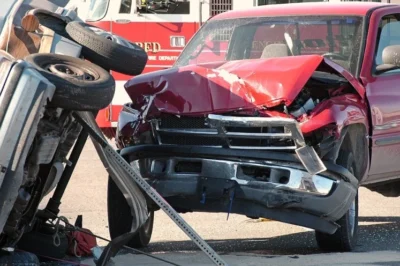Car Accident Lawyer Ocoee

Even a minor car crash can lead to medical bills, vehicle damage, and insurance headaches. If you’ve been injured in a collision caused by someone else, it’s important to have legal guidance you can trust. Weston & Pape represents car accident victims in Ocoee and works to hold negligent drivers accountable. Contact us at 561-821-3898 to speak with a car accident lawyer in a free consultation.
How to Prove That Speeding Contributed to a Car Accident in Florida
Car accidents can happen in the blink of an eye, and in many cases, speed is a contributing factor. If you’ve been involved in a car accident in Florida, proving that the other driver was speeding can make a significant difference in the outcome of your case. Speeding not only increases the likelihood of accidents but also intensifies the severity of injuries. In Florida, if you can prove that the other driver was speeding, you may have a stronger case for compensation.
To successfully prove that speeding contributed to a car accident, several pieces of evidence and strategies come into play. Understanding what evidence is needed and how to collect it will be essential to building a solid claim.
The Role of Speed in Car Accidents
Speeding is one of the most common causes of car accidents in Florida. Excessive speed can reduce reaction time, impair judgment, and increase stopping distances. In fact, studies have shown that every 10 miles per hour over the speed limit doubles the risk of a fatal crash. When a driver exceeds the speed limit, they may be liable for the accident, especially if speed was a contributing factor in the collision.
In Florida, the law mandates that drivers must obey posted speed limits and drive at a safe speed based on road conditions. This means that even if a driver is technically under the posted speed limit, they can still be considered negligent if the speed is unsafe for the conditions, such as poor weather, heavy traffic, or road construction.
Steps to Prove Speeding in a Florida Car Accident Claim
To strengthen your case and prove that the other driver was speeding, you will need to gather evidence and use legal strategies to establish liability. Here are the key steps in proving that speeding contributed to the accident:
Document the Accident Scene
The first step in proving that speeding was a factor is to thoroughly document the accident scene. If you are physically able to do so, take pictures or videos of the following:
- The damage to both vehicles, including any signs of heavy impact or destruction that might suggest high speeds.
- The location of the accident, including any road conditions, skid marks, and nearby speed limit signs.
- Any traffic or weather conditions that may have affected visibility or road traction, as these can help establish the context of the accident.
Witnesses can also play an important role. If there were other people who saw the accident or observed the other driver’s behavior before the crash, ask for their contact information. Eyewitness accounts can support your claim that the other driver was speeding.
Obtain the Police Report
In Florida, you are required to report accidents that result in injury or significant property damage to the police. The police report will contain crucial information such as:
- The statements from the driver and any passengers.
- The officer’s observations at the scene.
- Any citations issued, including whether the other driver was cited for speeding.
- The officer’s conclusion about the cause of the accident, which can support your claim.
While a police report alone may not definitively prove that speeding occurred, it can be an important part of your evidence and provide a professional assessment of the incident.
Use Skid Marks and Accident Reconstruction
In many cases, the presence of skid marks on the road can offer valuable insight into the speed of the vehicles involved. When a driver applies the brakes suddenly, the friction between the tires and the road can leave visible skid marks. By analyzing the length and pattern of these marks, accident reconstruction experts can estimate the speed of the vehicle at the time of the crash.
Accident reconstructionists use detailed mathematical formulas and engineering principles to analyze the physical evidence at the scene. They take into account factors like road conditions, vehicle type, and the point of impact to create an accurate picture of the accident’s dynamics. Their findings can be used to support your claim that speeding was a factor in the collision.
Examine the Vehicle’s Black Box Data
Modern vehicles are often equipped with event data recorders (EDRs), which are similar to the black boxes found in airplanes. These devices record information about the vehicle’s speed, braking, and acceleration during the moments leading up to an accident. If the at-fault driver’s car was equipped with an EDR, it may contain critical data that shows whether they were speeding at the time of the crash.
In Florida, EDR data can be subpoenaed as part of the discovery process in a personal injury claim. Your attorney can request this data if it’s relevant to your case. This data can be used as strong evidence to support your claim.
Consult with Expert Witnesses
In some cases, expert witnesses can provide valuable insight into the effects of speeding on the accident. Expert witnesses such as accident reconstruction specialists, engineers, and even medical professionals can testify about how the speed of the other vehicle contributed to the severity of the accident and the resulting injuries.
For example, an accident reconstruction expert can explain how a higher speed could have caused the driver to lose control of the vehicle or be unable to stop in time to avoid a collision. Similarly, medical experts can testify about the severity of the injuries and how they correlate with the impact speed.
Demonstrate the Driver’s Behavior Leading Up to the Accident
Often, the at-fault driver’s behavior leading up to the accident can provide indirect evidence that speeding was a factor. For example, if the driver was weaving between lanes, tailgating, or making dangerous maneuvers, it may indicate that they were speeding or driving recklessly.
Witness testimony can play a significant role in establishing this behavior. If there are witnesses who observed the driver’s actions before the crash, their statements can provide a stronger case for speeding.
Look for Traffic Citations or Violations
If the other driver was cited for speeding or any other traffic violation related to the accident, this could serve as direct evidence of negligence. Traffic tickets and violations are often considered persuasive evidence in personal injury claims. In Florida, if the driver was cited for speeding at the time of the crash, it can bolster your case by establishing that they were acting negligently.
Review Surveillance or Dashcam Footage
If the accident took place near businesses or intersections that have surveillance cameras, or if either party had a dashcam in their vehicle, these videos can be extremely valuable in proving speeding. Video footage can capture the speed at which the vehicle was traveling and provide clear evidence of the accident’s dynamics.
Dashcam footage from other drivers may also offer key evidence in cases where traffic violations or dangerous driving led to the crash.
What Happens If You Can’t Prove Speeding?
Even if you are unable to directly prove that the other driver was speeding, you may still be able to file a successful claim based on other factors. Florida follows a comparative fault rule, meaning that even if you are partially responsible for the accident, you may still recover compensation for your injuries, as long as you are less than 50% at fault. This means that you may be able to receive damages based on the other driver’s negligence, even if speeding is not definitively proven.
Connect with a Personal Injury Attorney for Your Ocoee Car Accident Case
After a car accident, your recovery should be the priority—not fighting with insurance companies. If you’ve been hurt in a crash caused by someone else, Weston & Pape can help you seek justice and compensation. A skilled personal injury attorney can assess your case and offer reliable advice. Call 561-821-3898 for a free consultation to get started.

 Call Us Today - It's Free
Call Us Today - It's Free